|
|
Great Ophthalmologist
|

Marshall Miller Parks
(1918 - 2005 ) American paediatric ophthalmologist.
|
Marshall Miller Parks (1918 - 2005 ) American paediatric
ophthalmologist.
• Parks is widely regarded as the father of paediatric
ophthalmology.
• Medical degree in St. Louis Medical School
• Served in the American Navy during World War II.. After
the war, he started
• Ophthalmic residency at the Illinois’ Great Lakes Naval
Hospital.
• His studies into amblyopia and strabismus earned him
world-wide reputation.
• He later practiced in the Children's Hospital in
Washington, D.C and offered paediatric ophthalmology as a
subspecialty.
• He is known for the Parks 3-step test. Which is designed
to identify a paretic, vertically acting muscle by noting
the eye with the hyperdeviation in the primary position,
horizontal gazes and on forced head tilt to the right and
the left.
|
|
|
|
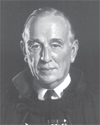
Sir Stewart Duke-Elder |
Sir Stewart Duke-Elder, a Scot, was a
dominant force in British and international ophthalmology
for more than a quarter of a century. He is best remembered
as a talented and prolific writer and editor, producing
seven volumes of Textbook of Ophthalmology and fifteen
volumes of System of Ophthalmology, along with many other
textbooks and scientific papers
that provided the educational foundation for most of the
world’s ophthalmologists. This monumental contribution to
medical literature earned him the title of Fellow of the
Royal Society in England. In addition to his own writings,
Duke-Elder served for many years as editor of British
Journal of Ophthalmology and Ophthalmic Literature and he
was instrumental in the formation and research direction of
the Institute of Ophthalmology in London. He was knighted in
1933 and subsequently earned many more honors, serving as
the Surgeon-Oculist to King Edward VIII, George V and the
present Queen Elizabeth. |
|
|
|

Dr. Kelman |
Dr. Kelman was born in Brooklyn, New
York, on May 23, 1930. After graduating from Forest Hills
High School and Boston's Tufts University, he completed
medical studies at the University of Geneva, Switzerland; an
internship at Kings County Hospital, Brooklyn; and residency
in ophthalmology at the Wills Eye Hospital, Philadelphia. He
has been in private practice in New York City since 1960.
In 1962 Dr. Kelman devised the cryo-probe for cataract
extraction.
In 1963 Dr. Kelman pioneered the use of freezing for the
repair of retinal detachments. Retinal cryopexy remains a
frequent adjunct in retinal surgery to this day.Kelman
introduced phacoemulsification,in 1967,
In 1975 Dr. Kelman began designing lens implants for use in
conjunction with cataract surgery;Neurosurgeons have adopted
the Kelman phacoemulsification machine for use in dissecting
tumors from delicate brain and spinal cord tissue in
children. In this way, the device has saved hundreds of
young lives.
At present, Charles D. Kelman, MD is working on several new
projects, including artificial blood vessels, artificial
corneas and a magnetic cataract extraction procedure that
will retain the patient eye normal ability to focus on near
and distant objects. Clinical professor of ophthalmology at
New York Medical College, Dr. Kelman holds the position of
attending surgeon at the New York Eye and Ear Infirmary and
Manhattan Eye, Ear and Throat Hospital. He is a consultant
surgeon at many hospitals throughout the world.
Dr. Kelman has been the recipient of several prominent
awards Special Recognition Award, the Ridley Medal by the
International Congress of Ophthalmology, the First
Innovators Award in Ophthalmology and received the Binkhorst
Medal, both from the American Society of Cataract and
Refractive Surgery, as well as the first recipient of the
Outstanding Achievement Award for excellence in cataract
surgery from the American Society of Contemporary
Ophthalmology. He was awarded the "Inventor of the Year
Award" by the New York Patent, Trademark and Copyright Law
Association for his development of the Kelman
phacoemulsification procedure. In June 1992, Dr. Kelman was
awarded the Prestigious National Medal of Technology by
President George H.W. Bush and at the International Congress
on Cataract and Refractive Surgery in Montreal, Canada, Dr.
Kelman was named "Ophthalmologist of the Century" for his
pioneering work in phacoemulsification.
Dr. Kelman is immediate past president of the American
Society of Cataract and Refractive Surgeons. He has written
hundreds of articles, papers and scientific books as well as
a book for lay readers on cataracts and an autobiography
entitled Through My Eyes (both from Crown Publishing). He
continues to teach his surgical techniques while devoting
his spare time to several new projects, including a musical,
The Right Pair of Shoes, and an album that was released by
Columbia Records. |
|
|
|
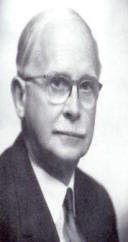
Sir Harold Ridley
|
During World War II,Sir Harold Ridley
observed that aviators could tolerate shards of PMMA
aircraft canopies in their eyes. He used this knowledge to
create and implant the first intraocular lens in a two-step
procedure between 1949 and 1950. Three years later, he
supervised the first IOL implantation in the U.S. and later
served as the first president of the International
Intra-Ocular Implant Club. Ridley’s cure for aphakia, once
ridiculed by his peers, is now a routine part of cataract
surgery. In addition to being the father of the intraocular
lens, Ridley has also made important contributions to
tropical medicine. He was made a Fellow of the Royal Society
in England in 1986 for his contributions to science and is
now retired in Salisbury, England. |
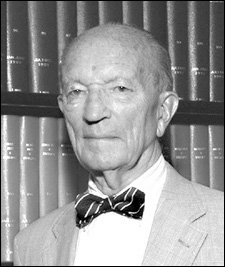
Charles Schepens |
The impact of
Charles Schepens’ contributions is immense.... His
strategy broadened and deepened the knowledge of the retina
to a point that it became a subspecialty of its own. Because
of his remarkable leadership he is revered as ‘The Father of
Modern Retina Surgery.’ Born in Belgium, he
served in the Belgian Air Force and the French Resistance
during World War II. He was captured twice by the Gestapo,
but survived to emigrate to the U.S. in 1947. Shortly
thereafter, he established the Retina Foundation, now known
as the Harvard-affiliated Schepens Eye Research Institute.
It is the largest independent eye research organization in
the U.S., a living legacy to the basic biomedical and
clinical eye research Schepens thought so important. He
invented the indirect binocular ophthalmoscope, which is now
routinely used to view the retina. His devices and surgical
techniques such as scleral buckling have been credited with
raising the success rate of retinal reattachment surgery
from 40% to 90%. Before his death in 2006, Schepens was a
professor emeritus of Harvard University. He was the founder
of Retina Associates in Boston, where he continued to
practice until his death. |
|
|
|
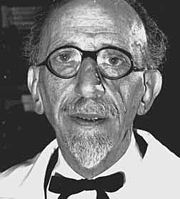
José Barraquer |
José Barraquer, who came from a
family that boasts four generations of prominent
ophthalmologists, is widely acknowledged to be the father of
refractive surgery. He was born in Spain, but moved in 1953
to Bogota, Colombia. There, he founded the Barraquer
Institute of America, where he trained many of the
refractive surgeons practicing around the world today.
Barraquer promoted the improvement of suture material and
technique in cataract and corneal surgery, and designed
numerous surgical instruments,
many of which still carry his name. But his life’s work was
dedicated to the idea of reshaping the cornea to change the
eye’s refractive power. Toward this end, he designed the
cryolathe and the microkeratome and developed keratomileusis
and keratophakia, laying the groundwork for LASIK and other
modern lamellar procedures. Barraquer continued to practice,
invent
and teach until his death last year. |
|
|
|
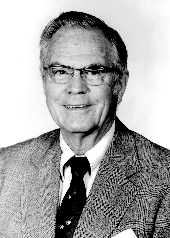
Edward Maumenee |
Edward Maumenee, the son of an
ophthalmologist from Mobile, Alabama, said once he wanted to
become the best ophthalmologist in the world, and many
believe he achieved that goal. In addition to being an
extremely highly regarded cataract and corneal transplant
surgeon, he also classified disorders of the macula,
discovered an important immune response in the rejection of
corneal tissue, and made pioneering contributions to the
understanding and treatment of retinal malfunctions and
glaucoma. Maumenee served as director of the Wilmer Eye
Institute at Johns Hopkins Hospital from 1955–1979 and was
director emeritus until he died last year. He was
instrumental in focusing national attention on the problem
of blindness, in the formation of a national eye-banking
system, and in the 1968 creation of the National Eye
Institute at the National Institutes of Health. His role in
the development of clinical and basic science in
ophthalmology is of lasting importance. |
|
|
|

Ramon Castroviejo |
Ramon Castroviejo, the son of a
Spanish ophthalmologist, came to the United States as a
young man to do a fellowship at the
Mayo Clinic. He stayed on at New York’s Columbia
Presbyterian Medical Center, where he performed the world’s
first successful human cornea transplant. Creating a
rectangular rather than circular “window” in the cornea was
the secret to his successful transplants. Although the
medical community was slow to recognize his successes,
Castroviejo was eventually lauded for his sight-saving
corneal tissue transplant techniques, which he continued to
refine and teach for many years. Castroviejo also promoted
the donation of corneal tissue in the United States and
designed numerous ophthalmic instruments. |
|
|
|
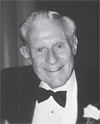
Lorenz
Zimmerman |
Born to German and Swiss immigrant parents
in Washington, D.C., in 1920, Lorenz Zimmerman
received his medical degree from George Washington
University. His residency training at Walter Reed Army
Hospital was interrupted by the Korean War,during which he
commanded a mobile medical laboratory in Korea. Returning
after the war to the Armed Forces Institute of Pathology, he
pursued his first love, ophthalmic pathology, chairing the
department for 29 years. As chairman, he developed training
programs and encouraged young ophthalmologists to go into
pathology. Zimmerman filled a void in ophthalmology and in
so doing, greatly improved the understanding of eye disease.
He continues to teach in the Washington area. |
|
|
|
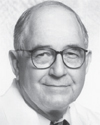
Donald Gass |
Donald Gass came to the field of medicine
almost by accident, but his contributions to ophthalmology
have been vast. After receiving his medical degree from
Vanderbilt University in 1957 and completing residencies in
ophthalmology at the Wilmer Eye Institute, Johns Hopkins
Hospital, Gass became very excited about combining his
interest in pathology with new techniques for viewing the
fundus with the fundus camera and fluorescein angiography.
He is well known for his research on diseases of the retina,
macula and uvea, much of which was done in Miami. Gass
continues to practice and is professor of ophthalmology at
both the University of Miami School of Medicine and
Vanderbilt University in Nashville. |
| |
(Source:The
American Society of Cataract and Refractive Surgery) |
| Ophthalmology Software :SquintMaster
Software | Pediatric Cataract
Management System Software | |
| |
|
Home
About |
|
|

